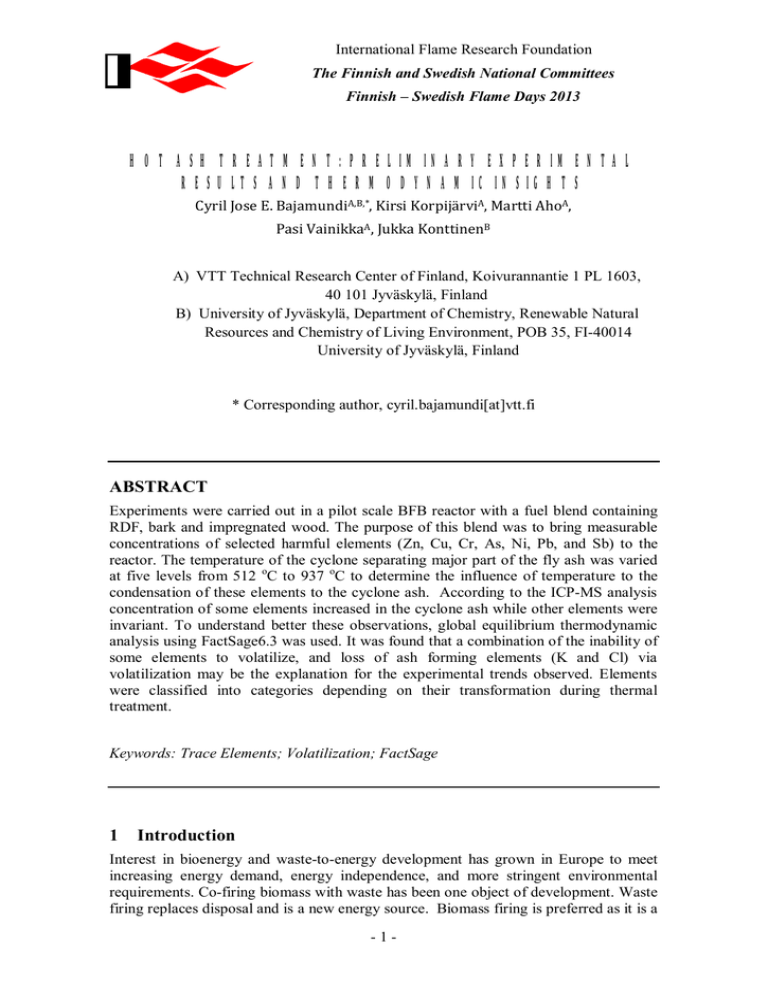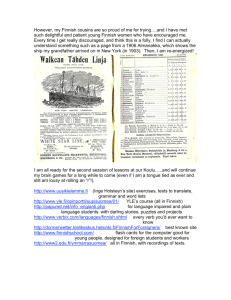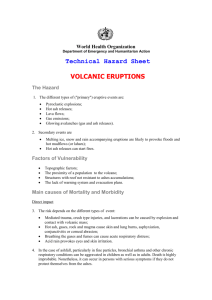HOT ASH TREATMENT: PRELIMINARY EXPERIMENTAL RESULTS AND THERMODYNAMIC INSIGHTS
advertisement

International Flame Research Foundation The Finnish and Swedish National Committees Finnish – Swedish Flame Days 2013 HOT ASH TREATMENT: PRELIMINARY EXPERIMENTAL RESULTS AND THERMODYNAMIC INSIGHTS Cyril Jose E. BajamundiA,B,* Kirsi KorpijärviA Martti AhoA Pasi VainikkaA Jukka Konttinen A) VTT Technical Research Center of Finland, Koivurannantie 1 PL 1603, 40 101 Jyväskylä, Finland B) University of Jyväskylä, Department of Chemistry, Renewable Natural Resources and Chemistry of Living Environment, POB 35, FI-40014 University of Jyväskylä, Finland * Corresponding author, cyril.bajamundi[at]vtt.fi ABSTRACT Experiments were carried out in a pilot scale BFB reactor with a fuel blend containing RDF, bark and impregnated wood. The purpose of this blend was to bring measurable concentrations of selected harmful elements (Zn, Cu, Cr, As, Ni, Pb, and Sb) to the reactor. The temperature of the cyclone separating major part of the fly ash was varied at five levels from 512 oC to 937 oC to determine the influence of temperature to the condensation of these elements to the cyclone ash. According to the ICP-MS analysis concentration of some elements increased in the cyclone ash while other elements were invariant. To understand better these observations, global equilibrium thermodynamic analysis using FactSage6.3 was used. It was found that a combination of the inability of some elements to volatilize, and loss of ash forming elements (K and Cl) via volatilization may be the explanation for the experimental trends observed. Elements were classified into categories depending on their transformation during thermal treatment. Keywords: Trace Elements; Volatilization; FactSage 1 Introduction Interest in bioenergy and waste-to-energy development has grown in Europe to meet increasing energy demand, energy independence, and more stringent environmental requirements. Co-firing biomass with waste has been one object of development. Waste firing replaces disposal and is a new energy source. Biomass firing is preferred as it is a -1- International Flame Research Foundation The Finnish and Swedish National Committees Finnish – Swedish Flame Days 2013 carbon neutral energy production method. Chemical and physical properties of waste differ from biomass. In contrast to biomass (especially of forest and plant origin) waste can be enriched with Zn, Pb, Sb, Cu, K, and Cl while biomass usually is more rich with Si, Al, Fe, Ca, Mg and Mn (Werkelin et al. 2010). Co-firing waste with biomass can give advantages: biomass addition reduces concentration of problematic elements by dilution. However, biomass can also contain risky elements. High potassium concentrations can increase risks of bed agglomeration in fluidized bed combustion and high chlorine concentrations make superheaters sensitive to corrosion. Therefore fuel co-firing should be carefully studied and optimized (Kouvo & Backman 2003). An additional key issue in co-firing is ash disposal or utilization. Both combustion technology and fuel composition influence ash quality (Pels 2012). Ashes are huge material sources but are classified as waste and their utilization usually needs an environmental permit. Different countries have different legislations governing the disposal or utilization of ash. Biomass ash fractions can end up as building materials(Garcia & Sousa-Coutinho 2013), filler in asphalt, elemental phosphorous production, landfill liners, and pollutant absorber(Pels 2012). For example in Finland biomass ashes can be utilized (without environmental permission) as fertilizers if the requirements of Fertilizer Product Act (591/2006) and Decree on Fertilizer Products (MMMa 24/11) are fulfilled. The requirements include e.g. maximum values for heavy metals. There is also same kind of limit values for utilization of biomass ashes in certain earth construction applications (VNa 591/2006) (Kilpimaa et al. 2013). The most sustainable way to utilize biomass ashes would be fertilizer use, but only a portion of the ashes fulfills the requirements, mainly because of too high content of heavy metals. Thus, refining the ashes in-situ via hot temperature separation of harmful substances during the combustion process could be an interesting option to get cleaner ashes for fertilizer use and also for other applications Concentration of seven elements (Zn, Cu, Cr, As, Ni, Pb and Sb) in fly ash has been studied as function of cyclone temperature during combustion of a blend containing RDF, bark and impregnated wood in a pilot scale BFB reactor. The expectation was that increase in cyclone temperature increases volatilization and improves in fly ash quality in the cyclone. The results obtained can hopefully be implemented in future power plant design. 2 Experimental / Methodology / Approach 2.1 Test Reactor A 20 kW bubbling bed reactor with bed diameter 0.16 m and height 0.55 m, freeboard diameter 0.23 m and height 3.5 m was used (Fig. 1) in the experiment. Electric heaters were placed to fluidizing-air heater, to bed area, to freeboard walls (three different types), to flue gas line between cyclone and freeboard and to cyclone area (indicated in Figure 1 by a dashed rectangular box) to produce (together with fuel energy) the desired temperature distribution to the reactor (Fig. 1). Table 1 lists the cyclone temperature for each test. -2- International Flame Research Foundation The Finnish and Swedish National Committees Finnish – Swedish Flame Days 2013 Bed material was natural sand with of 0.1 – 0.6 mm in particle size. The mean gas velocity was about 0.5 cm/s, which is sufficient to transport particles smaller than 100 m to the cyclone. Larger particles are expected to be deposited on the freeboard walls. Heating up close to the desired temperature was done with wood pellets, thereafter the fuel was changed to the final blend (see chapter 2.2). The stable period during which cyclone ashes were collected lasted 3 hours. Figure 1 Schematic diagram of the Bubbling Fluidized Bed setup at VTT and the temperature during the experimental runs. Table 1. Temperature of the cyclone for different test runs. Test Run 1 2 3 4 5 Cyclone Temp.,[oC] 512 622 724 827 937 2.2 Fuel and Air A fuel blend containing refuse derive fuel (RDF), bark, and chromated copper arsenate impregnated wood (CCA) with 28/70/2 mass portion was burnt. The purpose of this blend was to bring measurable concentrations of selected harmful elements (Zn, Cu, Cr, As, Ni, Pb, and Sb) to the reactor. The ultimate composition of the blend is given below. -3- International Flame Research Foundation The Finnish and Swedish National Committees Finnish – Swedish Flame Days 2013 Table 2. Ultimate analysis of the RDF-Bark-CCA wood mixture. Component C H N O[calc] Si Al Fe Ti Ca Mg P Na K S Cl Unit m% d.s. mg/kg d.s. Conc. Component 52.5 6.2 0.4 37.9 5222 2512 633 503 12300 1023 450 560 2000 1400 2700 Unit As mg/kg d.s. Cd Co Cr Cu Hg Mn Ni Pb Sb Tl V Zn H2 O m%a.r. Calorific Value MJ/kg d.s. Conc. 32 0.3 0.7 50 56 0.07 380 2.2 45 13 0.1 1.3 190 28.1 20.21 Mean fuel feeding rate was 51.6 g/min and combustion air feeding rate 11.16 mol/min (+ 1.24 mol/min N2 via the fuel feeding line) corresponding to an air/fuel ratio of 1.33. 2.3 Analysis of Ash Samples Cyclone ashes collected were microwave digested in a solution of HF-HNO3-HCl following the SFS-EN 13656 standard. The digestate was consequently analyzed for Zn, Cu, Cr, As, Ni, Pb, and Sb content using ICP-MS/OES. In addition XRF analysis was employed to measure the major fuel constituent. 2.4 Thermodynamic Modeling Thermodynamic equilibrium calculations in FactSage v 6.3 was used in order to explain the behavior of the heavy metals of interest. The database contained 319 ideal gas species and 421 pure solid species. In addition salt (FTSalt) and oxide (FTOxide) solid solution species were also included. All simulations were conducted at 1 bar and at temperatures indicated in Table 1. All nitrogen species were assumed to exist as N2. -4- International Flame Research Foundation The Finnish and Swedish National Committees Finnish – Swedish Flame Days 2013 3 Results / Modeling 1000 Cr Cu Zn 3000 2800 Concentration [mg/ kgdry solid] Concentration [mg/ kgdry solid] 3200 2600 2400 2200 2000 1800 900 Ni Sb As Pb 800 700 600 500 400 300 1600 200 500 600 700 800 900 1000 o 500 600 700 800 900 1000 o Temperature [ C] Temperature [ C] Figure 2. Trace element concentration profile for the cyclone fly ashes collected. From ICP analysis. According to our results, the elements under investigation can be classified into two categories: with (C1) and without (C2) clear dependency between the concentration in the cyclone ash and the cyclone temperature. Elements of C1 were Cr, Cu, Zn, Sb, Pb, among which Pb had a special behavior: its concentration decreased with temperature up to 720 where after a reverse trend was found (see Fig. 2). Elements of C2 were As and Ni (Fig. 2). To explain the apparent increase of concentration of elements with cyclone temperature and the special behavior of Pb, vaporization tendency of each element has been modeled and results are presented in Figure 3. Although thermodynamic equilibrium expects Pb to be in the vapor phase at the studied temperature range, it was found in the cyclone fly ash. This difference can be explained by additional kinetic and transport factors. Furthermore, the calculated trend of Cu and Cr (see Figure 3) suggests decreasing concentration vs. temperature due to volatilization. -5- International Flame Research Foundation The Finnish and Swedish National Committees Finnish – Swedish Flame Days 2013 1 Fraction in Gas [molGas/molIn] 1 Cr Cu Zn Ni Sb As Pb 0 0 500 600 700 800 900 1000 1100 500 600 700 800 900 1000 1100 o Temperature [oC] Temperature [ C] Figure 3. Fraction of elements (thermodynamically) expected to be in the gas phase at different temperature settings. To proceed, the dominant species of Pb has been collected from the result of the thermodynamic calculation and are shown in Figure 4. At the temperature range of 500OC – 750 oC majority of the Pb is present as PbCl2(g). At higher temperatures formation of the PbO(g) has been promoted to become the most abundant form of Pb at T > 850oC. This suggests that other elements, such as potassium which is rich in the blend, can abstract Cl from Pb. 0.01 0.0035 1E-3 0.0030 Pb(g) PbO(g) PbCl(g) PbCl2(g) 0.0025 As Species [mol] Pb Species [mol] 1E-4 1E-5 1E-6 1E-7 0.0020 AsCl3(g) AlAsO4(s) K3AsO4(s) 0.0015 0.0010 0.0005 1E-8 0.0000 1E-9 500 600 700 800 900 1000 500 600 700 800 900 1000 o Temperaure [oC] Temperaure [ C] Figure 4. Speciation of Pb (an element classified as C1) and As (an element classified as C2). -6- International Flame Research Foundation The Finnish and Swedish National Committees Finnish – Swedish Flame Days 2013 0.0044 2.0 0.0042 K Cl 0.5 1.0 0.5 (a) 0.0 0.0 500 0.0040 600 700 800 400 900 1000 Cond (b) 500 600 700 800 Fraction Condensed K Cl 1.5 Concentration [ wt%] Fraction in Gas [molGas/molIn] 1.0 0.0038 900 1000 Temperature [oC] Temperature [oC] Figure 5. (a) Concentration of K and Cl in the ash measured via XRF, (b) Volatilization trend of K and Cl and loss of the condensed phase as calculated in FactSage. Condensed phase is the whole ensamble of species which do not exist as gas phase, this includes the pure solid and solid solution species used in the modelling. A significant decrease in K and Cl concentrations in the cyclone ash with temperature was found (see Fig. 5a), which is in agreement with the volatilization predicted by thermodynamic equilibrium calculations. Simultaneously, elements originally present as chlorides have probably lost Cl, which strongly weakened their volatilization as function of temperature leading to apparent increase in concentration (see Figure 2). Similar trend was found by examining the fraction of the condensed species predicted by the model in Figure 5 (b). 0.4 O KCl(s) KCl(g) K3Na(SO4)2(s) K2SO4(g) Na Mg 0.3 K Species [mol] Element Al Si P S 0.2 0.1 Cl K (b) (a) Ca 0.0 0.0 0.2 0.4 0.6 0.8 1.0 1.2 1.4 1.6 500 600 700 800 900 1000 o Temperature [ C] Coeff. of Variation Figure 6. (a) Coefficient of variation of major ash forming elements and (b) major species of K. -7- International Flame Research Foundation The Finnish and Swedish National Committees Finnish – Swedish Flame Days 2013 To find out which major ash forming element/s is/are lost as temperature is increased; the coefficient of variation (cv) of the concentration of the elements was evaluated. Cv shows the extent of variability in relation to mean of the population, which is in this case, the mean concentration in the condensed phase for the temperature range of interest. Among the major ash forming elements shown in Figure 6(a), the K and Cl had the highest value of the cv, meaning that these two elements have incurred significant changes in concentration during heating, and in relation to Figure 5(a) (due to volatilization). In summary, thermodynamic models suggest that the trend in the concentrations of elements under class C1 can be explained by either or combination of the following reasons a) Inability of the trace elements to vaporize. b) Loss of ash forming elements due to volatilization. As for the elements in class C2, they remain in the solid phase thus their concentration did not vary significantly. 4 Acknowledgements We are thankful to VTT, and OSER project, Metso Power, Foster Wheeler, and the European Regional Development Fund for the resources shared to this study. In addition, Raili Taipale and Esa Kallio are acknowledged for providing key experimental data and information on the test parameters. REFERENCES Garcia, M.D.L. & Sousa-Coutinho, J., 2013. Strength and durability of cement with forest waste bottom ash. Construction and Building Materials, 41, pp.897–910. Available at: http://www.scopus.com/inward/record.url?eid=2-s2.084873623736&partnerID=40&md5=011eccdc90308e3e017ffcd83ec00bb4. Khan, A.A. et al., 2008. Scale-up study on combustibility and emission formation with two biomass fuels (B quality wood and pepper plant residue) under BFB conditions. Biomass and Bioenergy, 32(12), pp.1311–1321. Available at: http://linkinghub.elsevier.com/retrieve/pii/S0961953408000871 [Accessed March 20, 2013]. -8- International Flame Research Foundation The Finnish and Swedish National Committees Finnish – Swedish Flame Days 2013 Kilpimaa, S., Kuokkanen, T. & Lassi, U., 2013. Characterization and Utilization Potential of Wood Ash from Combustion Process and Carbon Residue from Gasification Process. Bioresources, 8, pp.1011–1027. Korpijärvi, K. et al., 2012. Utilization of ashes from co-combustion of peat and woodCase study of a modern CFB-boiler in Finland. In Ash Utilisation 2012 Ashes in a Sustainable Society. Available at: http://www.varmeforsk.se/files/program/askor/Korpijrvi.pdf [Accessed March 20, 2013]. Kouvo, P. & Backman, R., 2003. Estimation of trace element release and accumulation in the sand bed during bubbling fluidised bed co-combustion of biomass, peat, and refuse-derived fuels. Fuel, 82(7), pp.741–753. Available at: http://www.scopus.com/inward/record.url?eid=2-s2.00037400404&partnerID=40&md5=e2a711c4238ac1ecd88347f75576dab4. Maa- ja metsätalousministeriö, 2011. Maa- ja metsätalousministeriön asetus lannoitevalmisteista. , pp.1–27. Available at: http://www.finlex.fi/data/normit/37638-11024fi.pdf [Accessed March 20, 2013]. Pels, J., 2012. Overview of options for utilization of biomass ashes. In Ash Utilisation 2012 Ashes in a Sustainable Society. Available at: http://www.varmeforsk.se/files/program/askor/ECN_Pels_final.pdf [Accessed March 20, 2013]. Werkelin, J. et al., 2010. Chemical forms of ash-forming elements in woody biomass fuels. Fuel, 89(2), pp.481–493. Available at: http://linkinghub.elsevier.com/retrieve/pii/S0016236109004189 [Accessed March 20, 2013]. -9-





